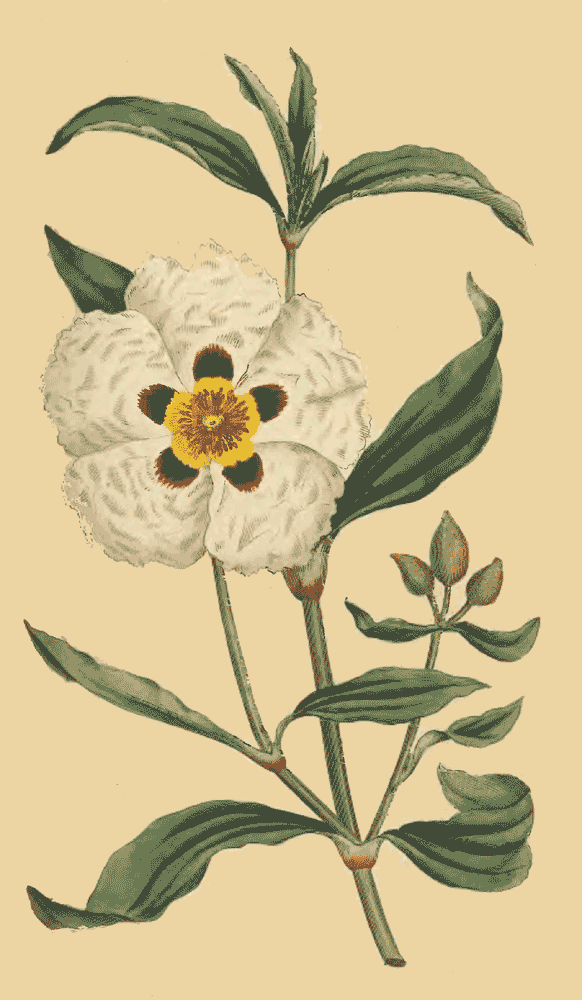Dies ist eine alte Version des Dokuments!
Cistaceae - common gum cistus, gum rockrose, Lack-Zistrose
Native fragrant shrub of the Mediterraneaen and North Africa; cultivated in France, Spain and Madagascar.
„Evergreen shrub of loose, open habit with very sticky, narrow, aromatic leaves, dark green above, grey beneath. Flowers to 10cm in width, white with a deep red blotch at the base of each petal“ http://www.rhs.org.uk/plants/details?plantid=2453
„It is a popular ornamental plant, grown for its strongly resin-scented foliage and conspicuous flowers. Its leaves yield a fragrant oleoresin known as labdanum, used in perfumes, especially as a fixative.“ http://en.wikipedia.org/wiki/Cistus_ladanifer
Cistus oil is the essential oil produced by solvent extraction or steam distillation of the twigs with leaves.
Among the volatile components of Cistus ladanifer leaves, the norisoprenoid 2,6,6-trimethylcyclohex-2-enone was identified as the main compound responsible for the leaf odor. [Volatile components of Cistus ladanifer leaves. Ramalho, Paula S., et al., Flavour and fragrance journal Vol.14 (5), 1999, 300-302]
The most common compounds found in cistus essential oil are: α-pinene (0-56%), camphene (0-10%), limonene (0-2%), p-cymene (0-4%), 2,2,6-trimethylcyclohexanone (0-11%), α-campholenic aldehyde (0-3%), bornyl acetate (2-3%), terpinen-4-ol (0-3%), allo-aromadendrene (0-1%), trans-pinocarveol (0-7%), borneol (0-3%), myrtenol (0-2%), ledol (0-13%), viridiflorol (0-21%).
[Characterization of the Portuguese-grown Cistus ladanifer essential oil. Gomes, Paula B., Vera G. Mata, and A. E. Rodrigues. Journal of Essential Oil Research, Vol.17 (2), 2005, 160-165] http://teresacasimiro.com.sapo.pt/Bibliographic_References/21.pdf
[Simultaneous distillation–extraction of high-value volatile compounds from Cistus ladanifer L., Teixeira, Salomé, et al., Analytica chimica acta 584.2, 2007, 439-446]
http://repositorio-aberto.up.pt/bitstream/10216/67702/2/12532.pdf
„Labdanum oil is a mixture of ca. 250 compounds… Only ten compounds, i.e., (-)α-pinene, (+)-camphene, pinocarveol, bornyl acetate, borneol, 2,2,6-trimethylcyclohexanone , (Z)-ocimenone, (-)-allo-aromadendrene/(+)-ledene, (+)-ledol, and viridiflorol, occur in concentrations above 1%, however, these do not represent the complex odor profile of the oil. The odor character of labdanum oil is on the contrary determined by a large number of oxygenated trace compounds such as (-)-ambrox, 6-oxoisoambrox and a decahydronaphthalenol, which are responsible for the distinct ambery character… The smoky-leathery notes and the animalic undertones are cuased by a complex of 25 phenols (1.5%)… The character-impact compound of oakmoss, methyl beta-orcinolcarboxylate, is responsible for the powdery, moss-like undertones… Another constituent, 2-methyloctanoic acid, has a strong labdanoic odor on its own, (and) 3,4,4-trimethylcyclopentane-1,2-dione… has a strong celery aroma.“
[S.Escher, Firmenich SA, unpublished results, cited by Roman Kaiser, Meaningful Scents around the World, Roman Kaiser, Zürich 2006, 313ff]

